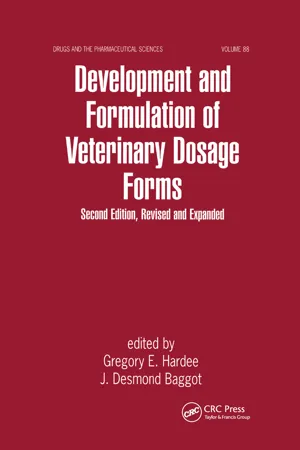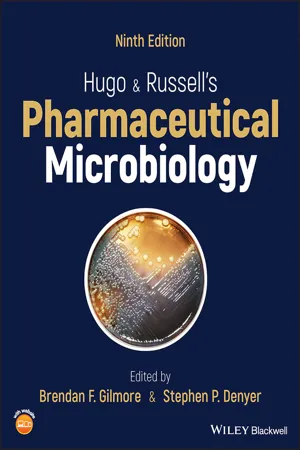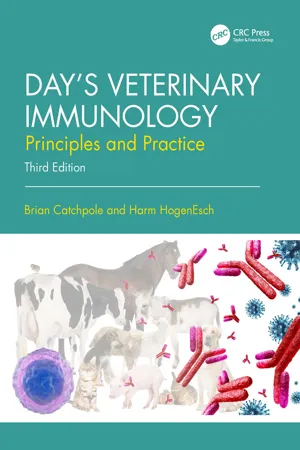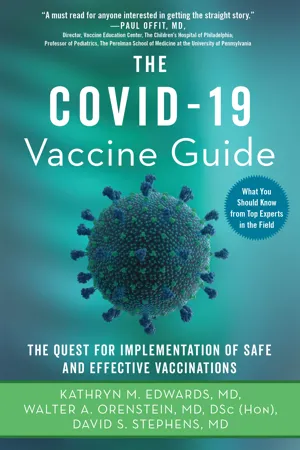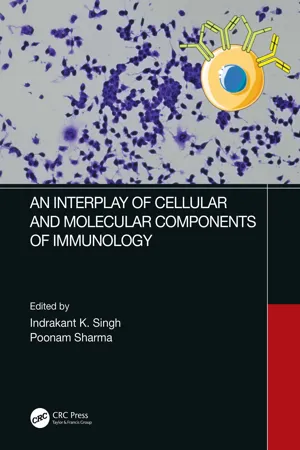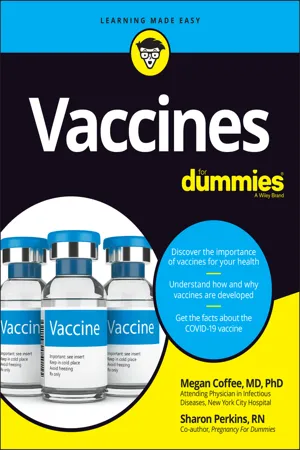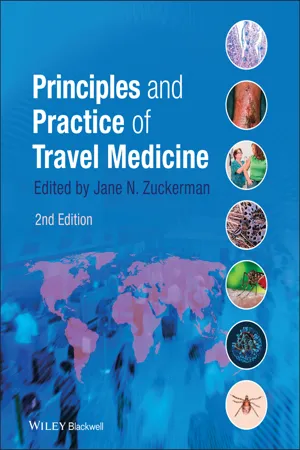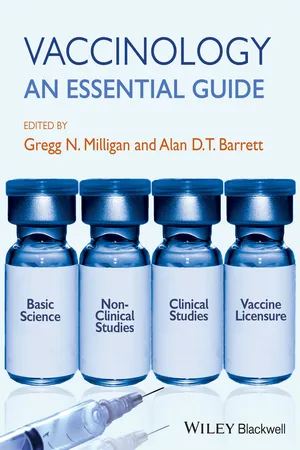Biological Sciences
Inactivated Vaccine
An inactivated vaccine is a type of vaccine that contains viruses or bacteria that have been killed or inactivated so they cannot cause disease. These vaccines stimulate an immune response in the body without causing the actual disease. Inactivated vaccines are often used to protect against diseases such as polio, influenza, and hepatitis A.
Written by Perlego with AI-assistance
Related key terms
9 Key excerpts on "Inactivated Vaccine"
- eBook - ePub
- Roar Gudding, Atle Lillehaug, Oystein Evensen, Roar Gudding, Atle Lillehaug, Oystein Evensen(Authors)
- 2014(Publication Date)
- Wiley-Blackwell(Publisher)
Non-replicating vaccines, as the term suggests, are vaccines whose design includes killed pathogens, their structures in native or synthetic forms, or their products as antigens. Safety is the main focus with these vaccines, since dead pathogens cannot cause disease. Nonetheless, they are able to provoke an immune response.3.2 Classification
The types of non-replicating vaccine in general can be classified into the categories listed below.3.2.1 Inactivated Vaccines
“Inactivated” is generally preferred to “killed” when referring to viral vaccines of this type, since viruses are not considered to be alive. Inactivated Vaccines account for the largest component of prophylactic treatments that led to reduction of bacterial diseases in aquaculture in Norway.The first generation of Inactivated Vaccines was developed by Louis Pasteur (Pasteur, 1880), streamlining the process into four basic steps, namely: (i) isolation of the pathogen; (ii) propagation; (iii) inactivation; followed by (iv) administering the inactivated microorganism into the host. Although these steps are still an integral part of modern Inactivated Vaccines, each of these steps has been streamlined in order to optimize vaccine performance. For example, step one has gone beyond basic isolation and characterization of the pathogen, but it has been expanded into identifying immunogenic components engaged in vaccine protection. Step two, which covers bulk propagation of the pathogen, has also been streamlined using different propagation systems such as bioreactors that enable production of the large quantities of vaccines needed to cope with the increase in demand for vaccines in aquaculture. In the case of step three, there are several procedures used for inactivation of pathogens that do not alter the antigenic structure of microorganisms.Inactivated Vaccines depend upon the inactivation of whole pathogen, and they account for the majority of commercial vaccines currently used in aquaculture. They have the advantage of being easy to make, ecosafe, and are less expensive. Inactivated bacterial vaccines account for the majority of the products on the market, followed by viral vaccines (Tables 3.1 and 3.2 - Gregory E. Hardee, J. Desmond Baggo, Gregory E Hardee, J D Baggot(Authors)
- 2021(Publication Date)
- CRC Press(Publisher)
A. Basic Definitions
1. Biological Product
Refers to “all viruses, bacteria, sera, toxins, and analogous products of natural or synthetic origin, live microorganisms, killed microorganisms, and antigen immunizing components of microorganisms intended for use in diagnosis, treatment, or prevention of diseases in animals” (6 ).2. Toxoid
A sterile, soluble, nontoxic material prepared from growing bacteria, separating the bacterial cells from the culture fluids and rendering the soluble liquid nontoxic. Toxoids may also be prepared by chemical synthesis or using recombinant DNA technologies.A vaccine containing a live microorganism that has been rendered avirulent or incapable of causing disease when given to the target or host animal.3. Modified Live Vaccine
A live bacterium or virus determined to be nonpathogenic, by genetic manipulation or other means, and has encoded and expressed genes from another microorganism.4. Vector Vaccine
This refers to a whole viral or whole bacterial or whole parasitic vaccine in which the active component has been rendered nonviable.5. Killed or Inactivated Vaccine
A fragment of the microorganism that has been shown to be immunogenic and can be used in place of the whole microorganism.6. Subunit Vaccine
B. Regulatory Considerations
Regulatory agencies throughout the world vary in scope and practice in regard to governing the production of veterinary biologicals. In the United States, veterinary biologicals are regulated by the United States Department of Agriculture (USDA) as provided by the March 4, 1913, Act of Congress (37 stat. 832-833, 21 U.S.C. 151-158). There are three main branches of the USDA which are directly involved in the licensing of veterinary biologics: licensing, located in Riverdale, Maryland, which is responsible for licensing all new veterinary biologics; Veterinary Biologics Field Office (VFBO, Ames, Iowa), which has responsibility for inspecting manufacturing facilities for compliance and investigating incidence reports involving the use of veterinary biologics; and the National Veterinary Services Laboratory (NVSL, Ames, Iowa), which has responsibility for confirmatory testing, pre- and postlicensing as well as diagnostic services to the veterinary biologics industry (6 ,7- eBook - ePub
- Brendan F. Gilmore, Stephen P. Denyer, Brendan F. Gilmore, Stephen P. Denyer(Authors)
- 2023(Publication Date)
- Wiley-Blackwell(Publisher)
Inactivated Vaccines therefore usually have to be relatively concentrated suspensions. In addition, careful control of the culture conditions and the inactivation process is essential to maintain consistency. Even so, such preparations are often rather poorly protective, possibly because of partial destruction of protective antigens during the killing/inactivation process or inadequate expression of these during in vitro culture. At the same time, because they contain all components of the microorganism, they can be somewhat toxic. It is thus often necessary to divide the total amount of vaccine that is needed to induce protection into several doses that are given at intervals of a few days or weeks. Such a course of vaccination takes advantage of the enhanced ‘secondary’ response that occurs when a vaccine is administered to an individual person whose immune system has been sensitised (‘primed’) by a previous dose of the same vaccine. The best‐known Inactivated Vaccines are whooping cough (pertussis), typhoid, cholera, plague, inactivated polio vaccine (Salk type) and rabies vaccine. The trend now is for these rather crude preparations to be phased out and replaced by better‐defined subunit vaccines containing only relevant protective antigens, for example, acellular pertussis and typhoid Vi polysaccharide vaccines. 23.2.1.3 Toxoid Vaccines Toxoid vaccines are preparations derived from the toxins that are secreted by certain species of bacteria. In the manufacture of such vaccines, the toxin is separated from the bacteria and treated chemically to eliminate toxicity without eliminating immunogenicity, a process termed ‘toxoiding’. Toxoids are often subject to variable composition depending on the detoxifying agent and method used, and on whether these processes are applied before or after purification. A variety of reagents have been used for toxoiding, but by far the most widely employed and generally successful has been formaldehyde - eBook - ePub
Day's Veterinary Immunology
Principles and Practice
- Brian Catchpole, Harm HogenEsch(Authors)
- 2023(Publication Date)
- CRC Press(Publisher)
It is critical that the chemical treatment does not destroy important antigenic epitopes of the organism. Killed bacteria included in vaccines may be referred to as ‘bacterins’. The inactivated types of vaccine are relatively safe and may be used in pregnant animals. Because inactivated organisms are less immunogenic than live organisms, these vaccines often require adjuvants to stimulate an effective immune response. The inactivated organisms do not replicate intracellularly and are therefore less likely to induce a CD8 + T cell response, with protection more dependent on the induction of antibodies. Furthermore, they are less suitable for use in young animals, because they are more susceptible to interference by maternal antibodies. 13.4.3 Subunit Vaccines A subunit vaccine does not contain an entire intact organism, but rather one or more specific immunogenic structural proteins or secreted toxins that are either isolated from cultures or produced by recombinant DNA technology. Bacterial toxins such as tetanus toxin are inactivated by treatment with formalin and are called toxoids. Expression of recombinant protein antigens is accomplished by inserting the gene encoding an immunogenic protein of interest (able to induce a protective immune response) into a plasmid for expression in bacteria, yeast, or insect cells. The recombinant protein can be harvested from cultures and incorporated into a vaccine (Figure 13.2). The recombinant protein can be further engineered to optimize its expression, stability and immunogenicity. Viral proteins sometimes self-assemble into virus-like particles, essentially virus particles that lack nucleic acid and nonstructural proteins. Subunit vaccines are extremely safe, but the proteins are often poorly immunogenic, and require an adjuvant to induce optimum immunity - eBook - ePub
The Covid-19 Vaccine Guide
The Quest for Implementation of Safe and Effective Vaccinations
- Kathryn M. Edwards, Walter A. Orenstein, David S. Stephens(Authors)
- 2021(Publication Date)
- Skyhorse(Publisher)
Chapter 2 Introduction to Vaccines and VaccinologyV accines are the most cost-effective intervention for preventing human disease. What is a vaccine? How does it work? How do vaccines protect?A vaccine is a substance, such as an inactivated protein from an infectious organism, that when given to a person induces an active immune response to prevent or mitigate a disease. Your immune system acts as an army. The immune system ideally detects the foreign invading germ (i.e., virus, bacterium, fungus), generally called a “pathogen,” and destroys it or contains it so that it cannot cause disease. What a vaccine does is give the immune system practice so that when it encounters the real pathogen, it is ready. Without practice from the vaccine, the pathogen can overwhelm an unprepared immune system, causing serious illness.The immune system can protect against infection and disease in two different ways. First, it can secrete immune proteins, called antibodies, into blood or tissues that bind to the invading pathogen and prevent it from multiplying or invading cells of the human body and enhancing the uptake of the pathogens into special cells (“phagocytes”) which destroy the pathogen. This aspect of the immune system is often called the humoral immune system. Critical players in this response are B cells and specialized B cells called plasma cells. The plasma cells produce the antibodies that circulate in the blood and other body fluids and tissues, which when encountering the pathogen neutralize it or bind to it, facilitating destruction of the pathogen by other cells of the immune system.Second, the immune system consists of specialized cells, called T cells, which destroy infected human cells and prevent the pathogen from spreading and causing serious disease. This aspect of the immune system is called the cellular immune system.A number of vaccines include substances called adjuvants or immune system helpers. These adjuvants enhance the immune response to the vaccine. In the United States, the most common adjuvants are aluminum-based compounds. But an increasing number of vaccines have other new adjuvants that stimulate immunity, particularly in the elderly or those with less-robust immune responses (see https://www.cdc.gov/vaccinesafety/concerns/adjuvants.html - Indrakant Kumar Singh, Poonam Sharma, Indrakant Kumar Singh, Poonam Sharma(Authors)
- 2022(Publication Date)
- CRC Press(Publisher)
In general, the Inactivated Vaccines lead to either a highly complex or grander inflammatory immune response when compared to the newer subunit vaccines because many pathogenic components are preserved. In spite of the disadvantages, Inactivated Vaccines have been used world over. Hepatitis A vaccine is an example of inactivated whole-cell vaccine containing strain RG-SB of hepatitis A virus which is inactivated through treatment with formalin. The Inactivated Vaccine is adsorbed on an adjuvant system which is the virosome formulation.13.6.4.1 Mechanism of Action
After injection, the complete pathogen is phagocytosed by the immature dendritic cells. The pathogen is digested inside the phagolysosome giving rise to several diverse antigenic fragments. These fragments are displayed on the surface of the cell as discrete MHC II: antigenic fragment complexes. In the lymph node, several TH 2 cells, each having a specific TCR for each antigenic fragment, are activated by the activated mature dendritic cell. The B cells possess specific BCRs for different antigenic fragments, which bind to the antigens that are draining along the lymphatic channels. Thus, each of the antigens is internalized followed by presentation as MHC II: antigenic fragment, and then recognized by suitable TH 2 cells. The TH 2 cells release different types of interleukins such as IL2, IL4, IL5 and IL6 which bring about B-cell activation, differentiation and proliferation. This is followed by isotype switching from IgM to IgG with subsequent formation of memory B cells. This complete process takes about 10–14 days. But in a vaccinated individual, contact with the pathogen will elicit a secondary response by activation of the memory B cells, leading to elevated levels of the different IgG molecules in just 24–48 hours.13.6.5 Subunit Vaccines
The subunit vaccine consists of a portion of the pathogen rather than the complete pathogen as in the case of attenuated or inactivated whole cell vaccine. Subunit vaccines contain inactivated antigenic parts of the pathogen which are necessary for provoking a suitable immune response. Subunit vaccines contain either one or many recombinant peptides/proteins or polysaccharides which are structural components of the pathogen against which the vaccine is to be developed. The subunit vaccines are comparatively more advantageous than traditional vaccines in terms of safety and manufacturing cost, as they contain well-known components of high purity. These vaccines are safer because of the absence of live organism; therefore, there is the absence of replication and also materials which can invoke unwanted responses of the immune system are absent. This accuracy in vaccine development is a costly affair because the antigenic properties of different possible subunits of a pathogen are scrutinized at length to know the specific combinations that can elicit not only effective but also correct immune response. At times, although a response is elicited, there is no surety that immunological memory will be generated in the right way.- eBook - ePub
- Megan Coffee, Sharon Perkins(Authors)
- 2021(Publication Date)
- For Dummies(Publisher)
Vaccines fall into two broad categories: whole-pathogen vaccines and subunit vaccines. They’re further subdivided into several other categories, including live vaccines, Inactivated Vaccines, toxoid vaccines, nucleic acid vaccines, and viral vector vaccines. This may seem unnecessarily complicated — can’t science come up with just one type of vaccine that covers a multitude of diseases? The answer is, no they can’t, in most cases, although there are some vaccines that can be combined into one injection.In this section, we look at the types of vaccines available today and the reason why certain vaccines are made the way they are. Most importantly, we explain how specific vaccines may affect you.Whole-pathogen vaccines
A whole-pathogen vaccine is made from — no surprise here — the whole germ that makes you ill. To continue the “Wanted” poster analogy we start earlier in this chapter, whole-pathogen vaccines are like a “Wanted” poster that shows the whole person. In the same way, whole-pathogen vaccines show your immune system a weakened (live) or dead (inactivated) version of the pathogen. In some cases, a vaccine provides a picture of a very similar pathogen, the way a “Wanted” poster may show a sketch rather than an actual person.Scientists aren’t resting on their laurels when it comes to creating vaccines. Vaccines of the future may be able to attack cancer cells before they spread, or to prevent complications from diseases such as HIV from occurring.Looking at live vaccines
Live vaccines are made from weakened or similar versions of the germs that cause disease. These bacterial or viral strains are weakened in the laboratory and cause usually no, or else few, symptoms when they’re given to you.After just one or two doses, these vaccines may protect you for years or even a lifetime. They create a long-lasting immune response much like a natural infection would, just minus the worrisome disease. These are some of science’s oldest vaccines. They are tried-and-true, and in some cases, having been used for many decades. - eBook - ePub
- Jane N. Zuckerman, Jane N. Zuckerman(Authors)
- 2012(Publication Date)
- Wiley-Blackwell(Publisher)
Table 14.1 ). Live vaccines consist of attenuated microorganisms that, with administration, mimic natural infection, but with significantly reduced virulence so they do not cause illness in most circumstances. They do not require adjuvants and are more likely to induce long-lasting or even life-long immunity following administration of a single dose by activating both the cell-mediated and humoral response.Table 14.1 Type of vaccinesLive vaccines Inactivated Vaccines Toxoid vaccines BCGMeasles, mumps, rubellaOral choleraOral poliomyelitisOral typhoidVaricellaYellow fever AnthraxCholera (oral, parenteral)Haemophilus (Hib)Hepatitis AHepatitis BInfluenzaJapanese encephalitisPertussisPlaguePneumococcusInactivated poliomyelitisRabiesTick-borne encephalitisInactivated typhoid DiphtheriaTetanus Inactivated Vaccines
Inactivated (killed) vaccines are used when live attenuated vaccines are not available or where reversion of an attenuated strain to wild type occurs with relative ease. Inactivated Vaccines do not stimulate infection or mimic disease, are generally less immunogenic, and initially induce a predominantly humoral response which provides less efficient immune protection. A primary course of several doses is usually required to induce a sufficient immune response and regular boosters are then often needed to provide long-lasting immunity through the stimulation of both the cell-mediated and humoral immune systems [2, 3].Contraindications
Contraindications to vaccination include previous anaphylaxis to a previous dose of the vaccine or any of its constituent components or excipients. Some vaccines, including influenza, yellow fever, tick-borne encephalitis and some rabies vaccines, are cultured in purified egg or chick embryo cells. Hypersensitivity to egg is a contraindication to influenza vaccine, and an anaphylactic reaction to egg contraindicates influenza, tick-borne encephalitis and yellow fever vaccines. MMR vaccine is cultured in chick embryo fibroblasts and experience has shown that it is unlikely to contain a sufficient quantity of egg proteins to stimulate a hypersensitivity reaction in those allergic to eggs. However, it is essential that it is administered under extreme caution in a hospital setting to those who are hypersensitive to eggs and chicken protein [6]. Skin testing and graded challenge or desensitisation has been successfully used in those allergic to influenza and yellow fever vaccines but this is not routine practice [7]. - eBook - ePub
Vaccinology
An Essential Guide
- Gregg N. Milligan, Alan D. T. Barrett, Gregg N. Milligan, Alan D. T. Barrett(Authors)
- 2014(Publication Date)
- Wiley-Blackwell(Publisher)
Unfortunately, little was known about the complexities of scale-up or the kinetics of poliovirus inactivation by formalin. When the first Inactivated Vaccines were licensed, all the manufacturers experienced production and quality control problems, culminating in the “Cutter Incident” of cases of paralytic poliomyelitis in 1955, which were caused by residual infectious virus in some of the new vaccine lots, particularly those produced by Cutter Laboratories. This led to the temporary suspension of the polio vaccine programs in the USA and elsewhere. Inactivated Vaccine was subsequently rereleased after additional safety tests demonstrated consistency in production and viral inactivation. As a consequence of the problems with the Salk vaccine, the regulatory functions at the US National Institute of Allergy and Infectious Diseases (part of the National Institutes of Health) were moved to a separate institute, the Division of Biologics Standards, ultimately becoming the modern Center for Biologics Evaluation and Research of the Food and Drug Administration.In the 1950s, Albert Sabin in Cincinnati and investigators at a number of other laboratories took the three strains of polioviruses (one each for the three serotypes of poliovirus) and passaged them repeatedly in monkey tissue cultures, testing them for attenuation by inoculating monkeys. The least neurovirulent of these, the Sabin vaccine candidate, was ultimately selected. Sabin field tested his oral vaccine in 75 million people in the former Soviet Union.Immunologically, the Inactivated Vaccine differs substantially from the attenuated vaccine in that Inactivated Vaccine only induces humoral immunity whereas the live virus vaccine induces both humoral and duodenal antibodies (see Figure 1.6 ).Figure 1.6 Serum and secretory antibody responses to orally administered, live attenuated polio vaccine and to intramuscular inoculation of inactivated polio vaccine. From Ogra PL, Fishant M, Gallagher MR (1980). Viral vaccination via mucosal routes. Review of Infectious Diseases 2(3); 352–369.In the 1960s, an adventious virus, simian virus 40 (SV40), which has been shown to cause tumors in rodents and can transform human tissue culture cells, was recognized in primary monkey kidney tissue cultures used to prepare some vaccines. It is estimated that up to 100 million Americans may have been exposed to SV40, which contaminated the inactivated polio vaccine when it was first introduced. In addition, SV40 also contaminated the first oral polio vaccine, but that contaminated vaccine was only given to people during the original clinical trials. Furthermore, SV40 has been found as a contaminant of some of the adenovirus vaccines given to military recruits during that same period of time. Once the contamination was recognized, steps were taken to eliminate it from future vaccines; no vaccines licensed for use in the USA or other countries currently are contaminated with SV40.
Index pages curate the most relevant extracts from our library of academic textbooks. They’ve been created using an in-house natural language model (NLM), each adding context and meaning to key research topics.

